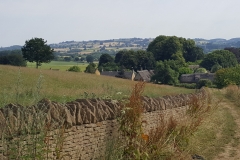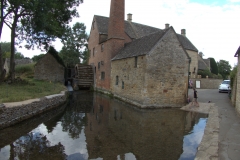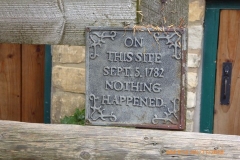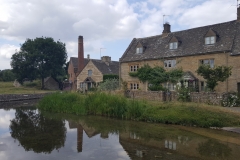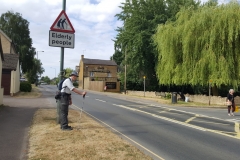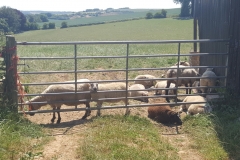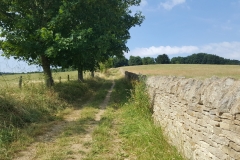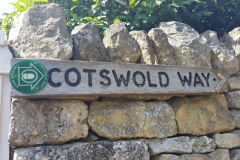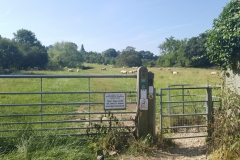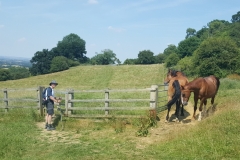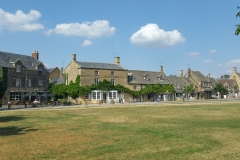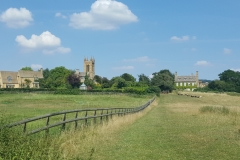
Did We Hike or Walk?
We just returned from a lovely stroll through the Cotswolds, English countryside designated as “an area of outstanding natural beauty”. With rolling hills, “wolds”, it is the second largest protected landscape in England (in case you are wondering, the Lake District is the largest). Also, in case you were wondering, a “cot” is a sheep enclosure. So the Cotswolds are a land of “sheep enclosures on rolling hillsides”. Inhabited since the bronze age, the area made its fortune and reputation on sheep and wool trade during the Middle Ages.
The villages are very beautiful with houses built of a distinctive, local, yellow-tinged limestone. The entire 800 square mile area is sparsely populated with only 140,000 people.
Our trip was through “Cotswold Walks”, a commercial venture that books B&B accommodations, provides detailed walking maps and transports your luggage from one B&B to the next. Our job was to wake up, have an English Breakfast and walk/hike from one B&B to the next over beautiful rolling hills.
Our itinerary
- 9 miles from Cheltenham to Winchcombe
- 9 miles from Winchcombe to Broadway
- 6 miles from Broadway to Chipping Campden
- 6-mile excursion to Kiftgate and Hidcote Gardens
- 8 miles from Chipping Campden to Moreton-in-the-Marsh
- 12 miles from Moreton-in-the-Marsh to Bourton-on-the-Water
- 10-mile excursion to Naunton and the Slaughters
With walking around town and some wrong turns we estimate about 65 to 70 miles total.
So, as the title of this blog asks, did we hike or did we walk the Cotswolds?
We used the term hiking but encountered a young person working a cash register who said we were walking. After all the company calls this Cotswold Walks not Cotswold Hikes. After a day of “walking” 10 miles through sheep fields, forests, cropland, dirt tracks, up and down 1,000 feet of climbing on irregular surfaces in 80+ degree heat, we felt we had hiked. His argument was that you hike up mountains on remote, narrow paths and you walk through the countryside.
Harummph. It is an interesting distinction though.
Same effort, different semantics.
We associate hiking with a greater accomplishment, more effort than a leisurely walk on a flat smooth surface and wanted to be recognized for it. The term walking was a subtle put-down to us but to the English, who frequently enjoy country walks, it was appropriate.
I saw the same thing in medicine
People would come in with an obvious head cold, sore throat, runny nose, and cough yet say emphatically
“I have the flu!
The flu means
“I am really sick and feeling bad … don’t demean my discomfort by telling me I have a cold and shouldn’t be here!!!”
Well, technically you don’t have the flu because you don’t have a flu virus, just a cold virus. You still feel bad. There is an antiviral drug for the flu, Tamiflu, but no treatment for the 300+ cold viruses, just palliatives that don’t work very well. Yes Virginia, antibiotics still do not work for a cold.
But semantics send subtle messages
The most financially successful family physicians I have known are very good at sensing a patient’s need for validation and tell the patient what they want to hear rather than what science says we should do. This contributes to the excessive use of antibiotics for “colds” and the current opioid crisis. Several times during my medical career I heard a patient emphatically express that the doctor’s job was to give the patient what they want … antibiotics, pain pills, and sleeping potions. I struggled with this my entire career.
One example
About half the time a patient comes to the family doctor with an earache, the ear canal and eardrum look perfectly normal. The problem is the jaw joint (TMJ) which lines one-third of the ear canal. Stress causes tension in this joint and ear (area) pain. In a busy office, the ten-minute resolution is to tell the patient they have an ear infection and prescribe an antibiotic. Happy patient, definitive treatment, get to the next patient, bill quickly, make more money.
The 30-minute resolution is to tell the patient they have a stress/mental problem and start talking about that. No definitive treatment, unhappy patient, other patients wait, make less money.
Similarly, the diagnosis of “sinusitis” without a runny nose or fever is more often a tension headache.
My personality did not suit a busy family practice thus I escaped to the less productivity, time-pressured University environment. I could spend time explaining why antibiotics were not a good idea and explore why they are unhappy.
Boy did I digress!!! So did we hike or did we walk?
We liked the distinction expressed by one Internet wag (paraphrased)
“You are hiking if you are on path where you can pee anytime you want to.”
Here is a quick selection of the 3,000 photos we took.
